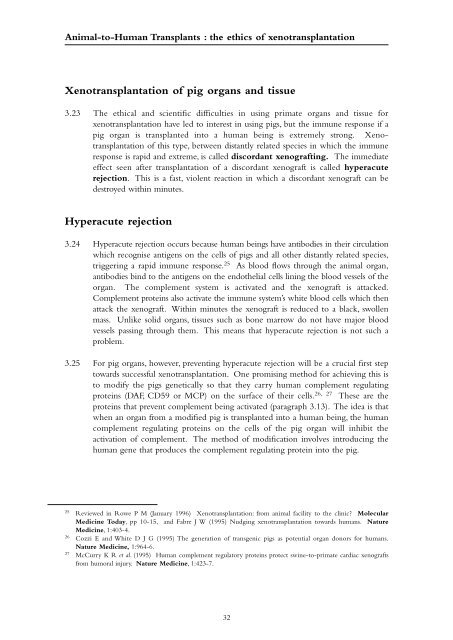Xenotransplantation - Nuffield Council on Bioethics
Xenotransplantation - Nuffield Council on Bioethics
Xenotransplantation - Nuffield Council on Bioethics
Create successful ePaper yourself
Turn your PDF publications into a flip-book with our unique Google optimized e-Paper software.
Animal-to-Human Transplants : the ethics of xenotransplantati<strong>on</strong><br />
<str<strong>on</strong>g>Xenotransplantati<strong>on</strong></str<strong>on</strong>g> of pig organs and tissue<br />
3.23 The ethical and scientific difficulties in using primate organs and tissue for<br />
xenotransplantati<strong>on</strong> have led to interest in using pigs, but the immune resp<strong>on</strong>se if a<br />
pig organ is transplanted into a human being is extremely str<strong>on</strong>g. <str<strong>on</strong>g>Xenotransplantati<strong>on</strong></str<strong>on</strong>g><br />
of this type, between distantly related species in which the immune<br />
resp<strong>on</strong>se is rapid and extreme, is called discordant xenografting. The immediate<br />
effect seen after transplantati<strong>on</strong> of a discordant xenograft is called hyperacute<br />
rejecti<strong>on</strong>. This is a fast, violent reacti<strong>on</strong> in which a discordant xenograft can be<br />
destroyed within minutes.<br />
Hyperacute rejecti<strong>on</strong><br />
3.24 Hyperacute rejecti<strong>on</strong> occurs because human beings have antibodies in their circulati<strong>on</strong><br />
which recognise antigens <strong>on</strong> the cells of pigs and all other distantly related species,<br />
triggering a rapid immune resp<strong>on</strong>se. 25 As blood flows through the animal organ,<br />
antibodies bind to the antigens <strong>on</strong> the endothelial cells lining the blood vessels of the<br />
organ. The complement system is activated and the xenograft is attacked.<br />
Complement proteins also activate the immune system’s white blood cells which then<br />
attack the xenograft. Within minutes the xenograft is reduced to a black, swollen<br />
mass. Unlike solid organs, tissues such as b<strong>on</strong>e marrow do not have major blood<br />
vessels passing through them. This means that hyperacute rejecti<strong>on</strong> is not such a<br />
problem.<br />
3.25 For pig organs, however, preventing hyperacute rejecti<strong>on</strong> will be a crucial first step<br />
towards successful xenotransplantati<strong>on</strong>. One promising method for achieving this is<br />
to modify the pigs genetically so that they carry human complement regulating<br />
26, 27<br />
proteins (DAF, CD59 or MCP) <strong>on</strong> the surface of their cells. These are the<br />
proteins that prevent complement being activated (paragraph 3.13). The idea is that<br />
when an organ from a modified pig is transplanted into a human being, the human<br />
complement regulating proteins <strong>on</strong> the cells of the pig organ will inhibit the<br />
activati<strong>on</strong> of complement. The method of modificati<strong>on</strong> involves introducing the<br />
human gene that produces the complement regulating protein into the pig.<br />
25<br />
Reviewed in Rowe P M (January 1996) <str<strong>on</strong>g>Xenotransplantati<strong>on</strong></str<strong>on</strong>g>: from animal facility to the clinic? Molecular<br />
Medicine Today, pp 10-15, and Fabre J W (1995) Nudging xenotransplantati<strong>on</strong> towards humans. Nature<br />
Medicine, 1:403-4.<br />
26<br />
Cozzi E and White D J G (1995) The generati<strong>on</strong> of transgenic pigs as potential organ d<strong>on</strong>ors for humans.<br />
Nature Medicine, 1:964-6.<br />
27<br />
McCurry K R et al. (1995) Human complement regulatory proteins protect swine-to-primate cardiac xenografts<br />
from humoral injury. Nature Medicine, 1:423-7.<br />
32
















